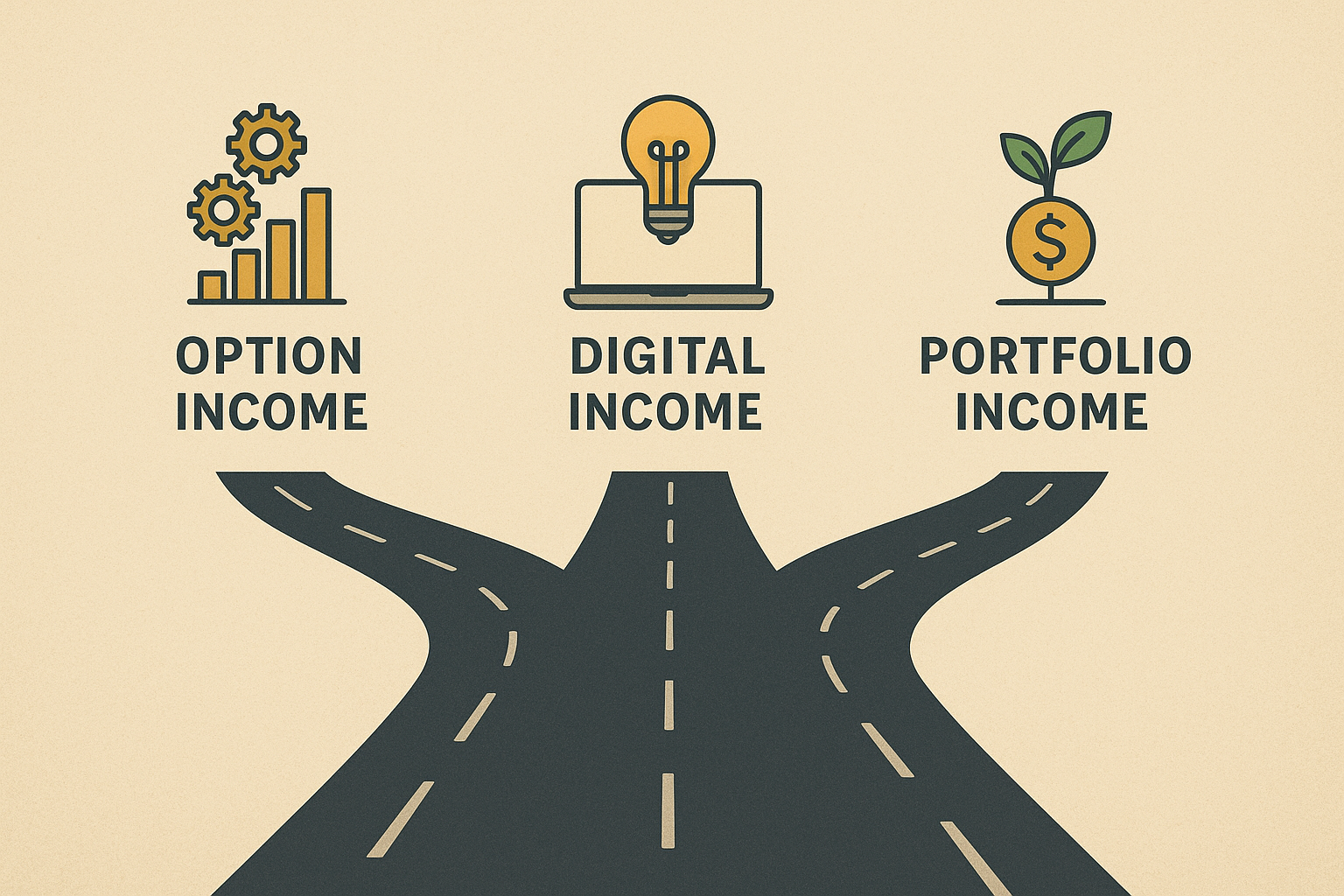Options or Not — 3 Income Paths You Can Start This Week

Hey — quick check-in before we dive: if your money isn’t paying you yet, that’s not your fault. Markets are loud and the latest shiny thing (0DTEs, anyone?) grabs headlines, but real cashflow comes from repeatable moves, not dopamine spikes.

This issue shows you three practical income paths — one option-focused (covered calls / cash-secured puts), and two that don’t require options at all. Pick one, do one small action this week, and you’ll already be ahead of 90% of people who wait for the “next big trade.”
🔍 Real Talk — Where the smart money is looking (and why it matters)
Short version: Institutional money and everyday investors are both flocking to income tools that pay now — especially covered-call strategies and derivative-income funds. That doesn’t mean there are no trade-offs. It means there’s a predictable way to get paid while you wait.
What the headlines actually mean (and what to do)
- Covered-call funds are seeing big inflows. Big money is moving into covered-call ETFs and derivative income funds because investors want yield in a low bond-yield world — and ETFs make the strategy simple to access. (This is a demand signal, not a promise of easy riches.) Reuters
Actionable nugget: If you’re curious, compare one covered-call ETF yield (look at distributions and fees) to a plain equity ETF. Note the difference and ask: do I prefer more income now or more upside later?
- Covered calls reshape risk — they don’t erase it. Covered calls trade some upside for immediate premium. That’s the trade: income today versus some missed upside if the stock rockets. Firms are packaging this logic into SMAs and ETFs because it’s useful for retirees and concentrated shareholders. Reuters
Actionable nugget: Pick one stock you’d be happy to own at a lower price. Model selling a one-month covered call at a strike you’d accept — if assigned, would you be okay holding it?
- Mechanics matter — know the rules before you sell premium. Fidelity and Schwab have solid primers on how a covered call and a cash-secured put work — the important bits are strike selection, position sizing, IV context, and assignment mechanics. Treat these like a process, not a gut feeling. Read Fidelity
Actionable nugget: Before you sell a put, write down the price at which you’d be comfortable owning the stock. If that price isn’t one you’d hold for years, don’t sell the put.
- 0DTE remains speculative — learn the rules if you play. If you still want to try short-dated trades, learn the set-ups and strict sizing rules first (TradingBlock lays out common 0DTE approaches). But remember: frequent, small bets compound both ways. See tradingblock.com
Actionable nugget: Cap any speculative 0DTE exposure to 2–5% of your tradable account, and journal every trade.
Quick, practical takeaway
If you want income and lower stress: start with covered calls or cash-secured puts on names you already like — keep position sizes sensible, and treat premiums as recurring revenue rather than one-off wins. If you prefer non-options routes, read on — there are two (equally practical) paths below.

⚡ Three income paths you can act on this week (pick one)
Path A — Options Income (practical & repeatable)
Ideal if you already hold stocks or want to buy at a target price.
- This week’s 10-minute task: Pick 1 stock you’d own at a lower price → check one-month call premium and one-month put premium → simulate selling 1 covered call or 1 cash-secured put (paper trade).
- Micro-rules: size so a single assignment doesn't overconcentrate you; avoid selling into earnings; set a rule for rolling or closing.
Why it works: You get paid now, and you either keep the premium or buy stock at a price you already liked.
Path B — Digital / Creator Income (skills → cashflow)
Ideal if you’d rather build an asset that sells while you sleep.
- This week’s 60-minute task: Outline a 1-page digital product you could sell (template, checklist, micro-course). Pick price, delivery platform, and one audience you’ll target (e.g., traders who want a simple covered-call checklist).
- Launch to 10 people, collect feedback, iterate.
Why it works: High leverage — a small upfront effort can scale; it’s controllable and doesn’t depend on market moves.
Path C — Passive Portfolio Income (ETFs, REITs, Alts)
Ideal if you want yield with minimal active management.
- This week’s 30-minute task: Screen 2 income ETFs (covered-call ETF vs dividend ETF) and note yield, fees, and distribution consistency. Allocate a tiny starter amount (2–5%) to feel the mechanics.
- Track distributions for the next couple months.
Why it works: Lower time cost; gives you a yield baseline while you experiment with more active income channels.

🔧 Smart Money Moves — immediate checklist (copy this)
- Paper-trade one income strategy (covered call or cash-secured put) for 2–3 cycles.
- Journal one metric each trade: premium collected, days held, time decay captured, and outcome.
- Cap speculative exposure to ≤5% of trading capital.
- Compare DIY vs ETF: factor fees, taxes, and your time.
- Subscribe & learn: pick one newsletter/resource to follow for deeper walkthroughs (see our picks below).

📬 Extra Edge — curated picks for this issue
Not an ad — these are practical next-step reads for each income path.
- Alts — Ideas for diversifying income beyond public markets (private credit, specialty income).
- Tech Fizz — Deep-dive investing ideas from tech themes (useful for pairing covered calls with tech holdings).
- TrendWise AI — Tools and data to spot income opportunities and manage risk with smarter signals.
👉 Browse and subscribe to any that help
📚 Resource Hub — Which tool to use depending on where you are
- If you want guided options practice: Super Investor Club (SIC) — community workshops, templates, and live breakdowns of covered-call and put strategies. (Best if you want help executing with real-world examples.)
- If you want to build non-market income: Go-Leap or a creator route — templates, quick launch frameworks.
- If you want passive yield with low fuss: research covered-call ETFs / dividend ETFs and start small (Morningstar/Fidelity primers are great reading). Morningstar
A gentle invitation
If you liked the options path and want hands-on templates, SIC is the place where people move from idea → practice without the guesswork. For this week only, new members get a Premium Income Checklist and a short group walkthrough (no hard sell — just a focused session).
👉 Learn more about SIC / join the next walkthrough →

Final note
You don’t have to do everything. Do one small thing this week — simulate one covered call, outline one digital product, or buy one small allocation to an income ETF. Consistency compounds faster than adrenaline. If you want, reply and tell me which path you picked; I’ll give a one-page checklist tailored to it.
Stay calm, get paid while you wait,
— Sky
